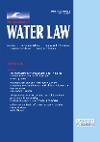Journal of Water Law - Volume 27 - Issue 2

ARTICLES
The management of groundwater underlying the Danube River basin: work-in-progress
ELENA QUADRI
WARREDOC – University for Foreigners of Perugia
This article focuses on groundwaters that underlie the Danube river basin and that are shared by the member states of the International Commission for the Protection of the Danube River Basin (ICPDR). The research aims to investigate whether – and the extent in which – groundwater falls within the ambit of the ICPDR. It continues to examine the legal and technical instruments adopted by the Danubian states, including the 1994 Danube River Protection, and more recently, the EU Water Framework Directive (2000/60/EC).
Neoliberalism and environmental water law: comparing the United States’ and Chile’s hydroelectric dam networks
ALEXANDER C NAGEL
PhD Candidate, University of Idaho Department of Geography, Idaho
This article conducts a comparative analysis between the legal dimensions of the United States Clean Water Act of 1972 and the Chilean Water Code of 1981, alongside associated environmental assessment policies related to hydropower projects. Consequently, this study seeks to provide insights into complex outcomes generated by two landmark legal policies that may mirror one another superficially, yet exist in heterogenous landscapes.
The groundwater crisis in India and relevant water governance in the making
HASRAT ARJJUMEND
Senior Fellow, Centre for International Sustainable Development Law, Montréal (Quebec), Canada
KONSTANTIA KOUTOUKI
Professor, Faculty of Law, Université de Montréal, Montreal (Quebec), Canada
The groundwater crisis in India has become a cause of concern for all. To address the groundwater problem, the Government of India passed the Model Bill for Protection, Conservation, Regulation and Management of Groundwater 2016 which includes provisions on decentralization, public participation, equity and social inclusion, ecological sustainability and microirrigation. This article addresses the challenges faced in implementing the provisions effectively and argues that groundwater consumption needs to be minimized through increased water efficiency in agriculture.
Where are the banks of a river? Property and the extent of rivers
MICK STRACK
Senior Lecturer, National School of Surveying, University of Otago, New Zealand
Although banks of rivers are regularly depicted as property boundaries, it is not always clear where those boundaries lie or what the extent of a river is and what defines its banks. This paper looks back at the various arguments surrounding the previous uncertainty about the extent of a river and the determination of where the bank is to conclude that a Cadastral Surveyor can use practical observation and the legal definition to determine the property boundaries defined by the bank of a river.
